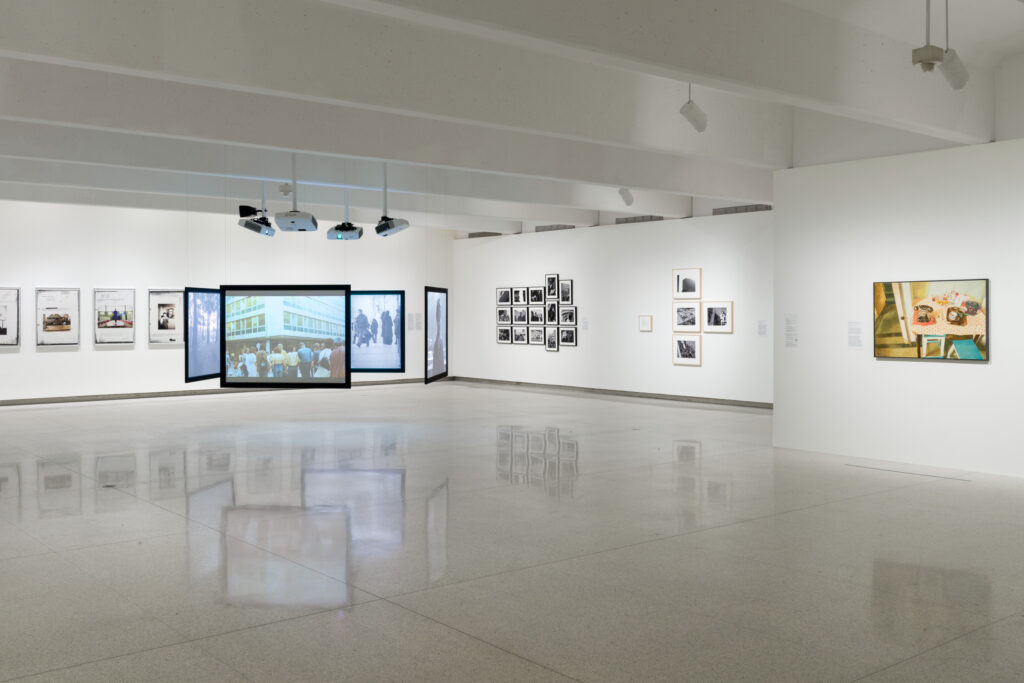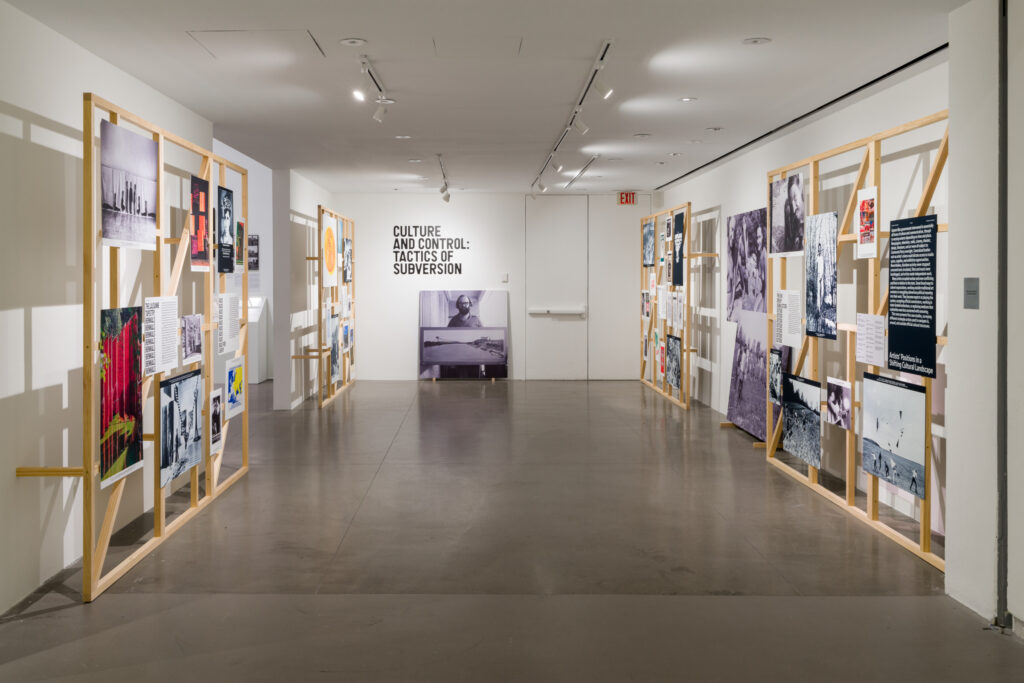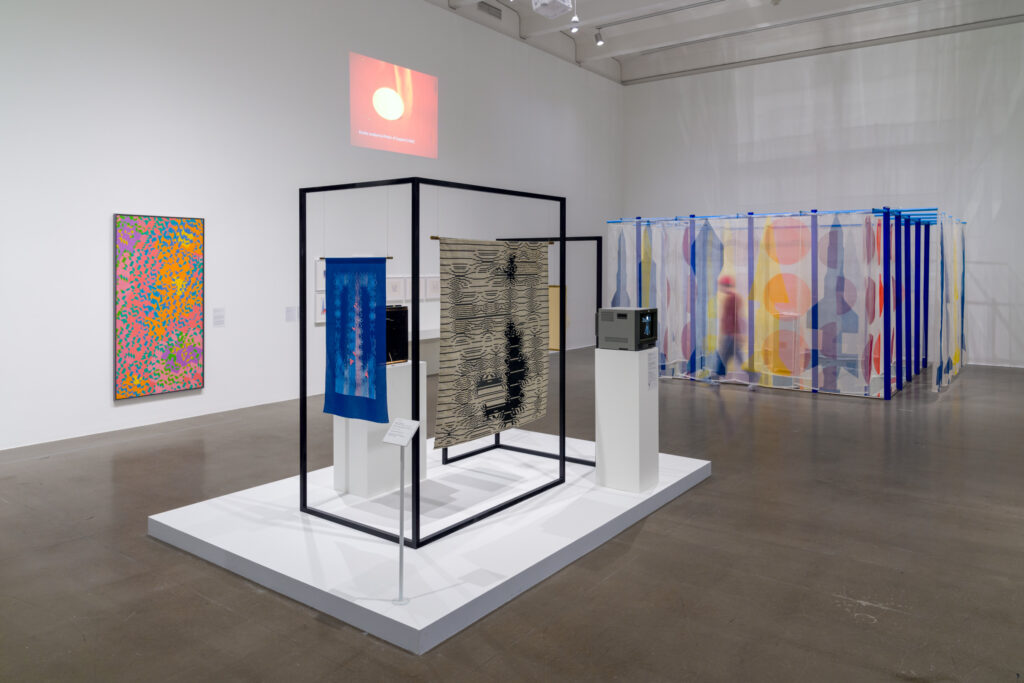Multiple Realities: Experimental Art in the Eastern Bloc 1960s-1980s
Multiple Realities: Experimental Art in the Eastern Bloc 1960s-1980s, at Walker Art Center, November 11, 2023 – March 10, 2024; Phoenix Art Museum, April 17, 2024 – September 15, 2024; and Vancouver Art Gallery, December 14, 2024 – April 21, 2025
Thirty-two years after the collapse of the Soviet Union, the exhibition Multiple Realities offers a geographically expansive introduction to the creative autonomy that existed behind the Iron Curtain. To the average—which is to say non-specialist—viewer, Multiple Realities provides an intelligible, though not altogether nuanced, view of the Cold War East as a space ruled by ideological inflexibility. Nevertheless, the breadth of artworks curator Pavel Pyś compiled for the exhibition demonstrates—albeit often subtly for the uninitiated viewer—the agency and freedoms, both creative and political, that artists in Central and Eastern Europe maintained. Featuring approximately 250 works of art by nearly 100 artists from six different countries (the German Democratic Republic, Poland, Czechoslovakia, Hungary, Romania, and Yugoslavia), the show provides a wide-ranging entry into the innovative and defiant spirit of artists who worked and sometimes even thrived in the shadow of their oppressive regimes from the 1960s through the 1980s. National divisions and frameworks take a conspicuous backseat throughout Multiple Realities, underscoring the show’s prioritization of the shared conceptual and aesthetic impulses that served to unite artists in the Eastern Bloc across national boundaries. This is an important curatorial move, and one that reinforces an ongoing trend in the study of Central and Eastern European postwar art not to present that art as a mere illustration of national politics and Cold War ideology.

Installation view, Multiple Realities: Experimental Art in the Eastern Bloc, 1960s–1980s. Photo: Eric Mueller. Courtesy Walker Art Center.
Organized by the Walker Art Center in Minneapolis and curated by Pavel Pyś with additional in-house support by William Hernández Luege and Laurel Rand-Lewis, Multiple Realities excels with the impressive number and breadth of artworks it includes, drawing attention to the myriad material and conceptual impulses that motivated artists in the Cold War era to make art. The value of an exhibition of this scale and in a venue with such a broad international appeal is certainly beyond question, and speaks to the growing interest in a more expansive definition of art made in the Eastern Bloc. With an initial span in Minneapolis from November 11, 2023 to March 10, 2024, the show travels to the Phoenix Art Museum (April 17 – September 15, 2024) and the Vancouver Art Gallery (December 14, 2024−April 21, 2025). Multiple Realities is a watershed for North American exhibitions on the subject of Cold War-era art from the Eastern Bloc, comparable only to the New Museum’s Ostalgia show of 2011. Needless to say, the thirteen years in between these two exhibitions signals the slow growth of interest in the American contemporary art museum context. In contrast, the scholarship on the subject has increased rapidly in the past decade. Unfortunately, even the Multiple Realities catalog scarcely engages with the field’s major thinkers.
The omission of contemporary scholarship oddly contrasts the curator’s stated objective to present a more complicated history in the exhibition. As Pyś writes in his catalog introduction, “The enduring simplification that all Central Eastern European artists needed to orient their work politically vis-à-vis the demands of state ideology demands unpacking; How might a more subtle, nuanced, and truer appreciation of the relationship between politics and art that was at play for artists in Central Eastern Europe be approached?” (p. 18) To address this question, Pyś divided the exhibition into four thematic sections, plus four separate informational displays that offer historical and contextual background information: “Public and Private Spaces of Control”; “Dimensions of the Self”; “Being Together: Alternative Forms of the Social”; and “Looking to Other Futures: Science, Technology, Utopia.” The wooden scaffolding design of these four informational displays provides a visual appeal that in some ways mirrors the improvisational and often provisional strategies employed by artists included in the main exhibition spaces. This being said, because the four informational sections function primarily as self-contained displays that provide context and chronology—something the exhibition otherwise resists—I will not address them together with the thematic sections.

Installation view, Multiple Realities: Experimental Art in the Eastern Bloc, 1960s–1980s. Photo: Eric Mueller. Courtesy Walker Art Center.
Multiple Realities remains faithful to the thinking of Piotr Piotrowksi, a founding figure who argued for the necessity of studying the art of the Cold War era from Central and Eastern Europe on its own terms, instead of as a derivative of Western art history. To wit, in his introduction Pyś quotes Piotrowski thus: “Art historians should realize that a canon is always an effect of an analytical and historical construction––more dependent on the historian than on the art accounted for” (p. 36). In its efforts to resist chronologizing or nationalizing culture Multiple Realities provides an opening for the art of Central and Eastern Europe to be interpreted within its own conceptual, aesthetic, or material frameworks, which parallel but often run counter to traditional (that is to say, Western) art history.
In important ways, Multiple Realities does much to embody the kind of capacious and inclusive historiography that can help correct the stark absence of this often forgotten or maligned art from the Cold War era. In other ways, though, the exhibition and its catalog preserve the traditional narrative that holds that the art of the Cold War can only be understood in its relationship with state oppression. Such a vantage point reinforces the binaries of East versus West that more than three decades of scholarship by figures like Piotrowski, Amy Bryzgel, Klara Kemp-Welch, Katalin Cseh-Varga, Zdenka Badovinac, Jasmina Tumbas, and myself, among others, have sought to negate. This being said, even as the exhibition’s frameworks recapitulate popular, but not scholarly, opinion on art made “behind the Iron Curtain,” the artworks themselves do much to counter such simplified analyses. Furthermore, the very quantity of work in the show helps repair the lapses in the exhibition’s conceptual vision.
Multiple Realities’ inaugural section “Public and Private Spaces of Control” leans immediately into the most salient image of Eastern Bloc culture. Photography and photo-based works (specifically, paintings derived from photographs) engage, as the wall text explains, “issues of control and surveillance in public and private spaces.” It is important––even unavoidable––to engage with the mechanisms of surveillance that proliferated in the Eastern Bloc. While the contemporary German photographer Simon Menner’s Secret House Searches (2011-12) presentation of Polaroid images taken by Stasi agents during raids in private homes offers significant historical information, the exhibition would have done well to set these state-generated records in conversation with works like Matei Lăzărescu’s Kitchen Table (1978) or Lászlo Fehér Underground Passage (1975), the painting that opens the show. Lăzărescu’s photorealistic painting eerily mirrors the photographs Menner has pulled from the Stasi archives; Fehér’s black-and-white painting of a series of people walking up a stairwell includes an intentional crumple within the frame. That marring of the surface at once reminds the viewer that Fehér’s source is an actual photograph, and that this image has been somehow rescued from the bin. A reading of these works in combination with Cornelia Schleime’s phenomenal Stasi Series (1993) in which the artist restages segments of her surveillance file, Ewa Partum’s Self-Identification series (1980), and Sanja Iveković’s Triangle (1979), readily suggests that citizens across the Eastern Bloc were quite aware that they were being watched. In short, Eastern Bloc citizens were savvy about the world within which they lived. This is not to say that awareness equals empowerment. Nevertheless, Multiple Realities might have offered a more nuanced argument about the impact of surveillance, one that weighs the quality of surveillance and its impact over quantity. Scholarship that questions the influence of secret police operations is plentiful, and these arguments could have been readily added to this section of the exhibition.(On the East German context see, for example, Konrad Jarausch, “Between Myth and Reality: The Stasi Legacy in German History,” German Historical Institute Bulletin 9 (2014): pp. 73–83; and Julia Hell, “Loyal Dissidents and Stasi Poets: Sascha Anderson, Christa Wolf, and the Incomplete Project of GDR Research,” German Politics and Society 20, no. 4 (Winter 2002): pp. 82–118.)

Installation view, Multiple Realities: Experimental Art in the Eastern Bloc, 1960s–1980s. Photo: Eric Mueller. Courtesy Walker Art Center.
The adjoining gallery, which houses the section “Dimensions of the Self,” features works that represent “negotiations of embodiment in relation to sexuality, gender, joy, eroticism, stress, and duress.” An array of textile-based pieces appear sumptuous alongside the body-inspired sculptural works and photographs that explore themes of self-representation. Within the study of art made in the Eastern Bloc, body-based practices are fairly well understood, particularly in relation to questions of gender, but also to the physical culture of socialism, whose state-produced visual culture prioritized youthful and athletic bodies.(See, for example, Bojana Pejić, ed. Gender Check: Femininity and Masculinity in the Art of Eastern Europe, exhibition catalog (Cologne: Walther König, 2009).) What surprises in this gallery, and what is a true strength of Multiple Realities overall, are the examples of artworks whose handmade qualities are wedded to an autobiographical or erotic element. For example, for her work Vestiges (1978), Geta Brătescu arranges remnants of fabrics she inherited from her mother. A shared color palette––coral commingles well with a repetition of ochre and puce––unifies the combination of patterns and builds a narrative into an otherwise highly abstract portrait of the artist’s mother. Composed of tatters rather than carefully cut shapes, Brătescu quilted Vestiges in an improvisational and casual manner that reveals the intimacy the artist has with the body these textiles once dressed. Maria Pinińska-Bereś’s Erotic Swaddling Blanket (1974) evinces a similar tenderness, albeit in the form of a piece of furniture, which––as suggested by the piece’s title––couples the sexually-explicit image of a phallus with the love of caring for an infant, here represented in the ripples of a soft white textile. On display nearby is Barbara Falender’s Erotic Pillows series (1973-76). Displayed directly on the ground, these marble sculptures are contortions of male and female genitalia. The softness of the material, namely Falender’s masterful shaping of this stone, conjures a desire for touch that is likewise present in the Brătescu textile-work and in Pinińska-Bereś’s bench.

Installation view, Multiple Realities: Experimental Art in the Eastern Bloc, 1960s–1980s. Photo: Eric Mueller. Courtesy Walker Art Center.
While the artists mentioned above traffic in abstraction, the majority of those represented in the “Dimensions of the Self” section are far more explicit in their engagements with the body. Gabriele Stötzer’s photo series vacillate between the playful and the arcane––for example, the twelve-print In Front of Each Other (1984), for which a woman’s hair has been pulled back and sutured to the wall into a pentagram series strikes a fine balance of funny and witchy. In other works by Stötzer, such as Fusion (1982-83), the artist has overpainted twelve copies of the same photograph of two headless nude women with dots, lines, and smears. Of course, while artists in the western world, and in particular feminists, used the body as a medium that could both metaphorically and literally transcend the restrictions they faced as women in a post-WW2 consumer-driven world—as addressed in Natalia Sielewicz’s essay for the catalog—in Eastern Europe, the artists’ interest in the body was coupled with a desire to recast the authority of state culture by feminizing it. For their part, men also sought to articulate oppression on their bodies through works that centered on their vulnerability and that queered authority exercised by (and often centered on) men. To its credit, Multiple Realities does make this point, notably by exhibiting Kálmán Szijártó’s Transformations photo series (1977-82) and Krzysztof Jung’s pencil drawing Sleeping Man in Bed.(Interested readers are advised to consult 2010’s Gender Check: Femininity and Masculinity in the Art of Eastern Europe exhibition catalog as well as Piotrowski’s 2005 In the Shadow of Yalta for more information.)
While the third section of the exhibition, “Being Together: Alternative Forms of the Social,” might have benefitted from examples of mail art, the display is rich despite this lacuna, especially in its attention to LGBTQ+ life. For example, the photographs from the Queer Archives Institute(As described on its website, founded in November 2015 by Karol Radziszewski, “the Queer Archives Institute is a non-profit artist-run organization dedicated to research, collection, digitalisation, presentation, exhibition, analysis and artistic interpretation of queer archives, with special focus on Central and Eastern Europe.” For more information see: http://queerarchivesinstitute.org/) as well as a film by Gino Hahnemann that turns the story of Martin Luther into a homoerotic foray into nudity and the occult illustrate some continuity across queer subcultures. Similarly, though not squarely in keeping with its aim to focus on community building, this section also includes works of art that reflect global aesthetic and conceptual continuities. Highlights include Milan Adamčiak’s Dice Game + Variation 1 for John Cage (1964), as well as Teresa Gierzyńska’s musical series from 1970, both of which also document the important presence of the Fluxus movement in the Eastern Bloc countries. This section of the exhibition closes with the show’s most vibrant artworks, examples of graphic design produced in the Eastern Bloc. The selection is varied and compelling. Three examples, each from György Kemény, broadly represent the range of purposes that graphic design could serve: from public service announcements (“The braking distance was not observed!”), to film posters (“To Sir, with Love”, an American film which starred the Civil Rights advocate Sidney Poitier), to standard means of advertising (“New Swimwear!”). What is missing, however, both from the show and from its catalog, is a historical account of the internationalism of graphic design in the Eastern Bloc. This is a crucial omission because design was not only a point of continuity across Central and Eastern Europe, but also connected artists from these countries to those working in the communist countries of the Global South, as well as with activists in the United States and Western Europe.

Installation view, Multiple Realities: Experimental Art in the Eastern Bloc, 1960s–1980s. Photo: Eric Mueller. Courtesy Walker Art Center.
The majority of the artworks in the exhibition’s final section, “Looking to Other Futures: Science, Technology, Utopia,” were made using computer-based techniques or with synthetic materials, such as glass and metal. As far as the computer goes, the animations and drawings in the show readily reveal their origin in technology-enabled automation. For example, the digital imagery by Zdeňka Čechová, first begun in 1969, has a stilted quality explained by the crude nature of the computer technologies available at the time. Čechová’s later work in textiles demonstrates a progression both in her own visual interests and in the emerging capacity of computers to produce more organic-looking lines. Meanwhile, the sculptural works in this section, with Stano Filko’s immersive installation Poetry on Space-Cosmos (1967-70) being a signature example, likewise embrace material transparency. Shining surfaces of glass––either clear or mirrored––reflect the light of bare bulbs and tubes of color. The section “Looking to Other Futures” also reveals a regional fascination with cybernetics, demonstrating the ways in which Eastern Bloc countries kept up with technologies that were emerging globally. The work in this section is so rich that it could define its own exhibition. For example, curator Pyś’s choice to include Natalia LL’s performance-based video work Points of Support (1980) provides an entry point into thinking through the ways that technology may broaden discourses on gender, as well as on gender-expression. In Natalia LL’s 67-minute film, the artist appears posing as eighteen constellations within a natural landscape. Asserting both the materiality of her body and its ability to represent the world outside it, Natalia LL creates a metaphor for the ways that life remains rooted in a shared experience of matter.

Installation view, Multiple Realities: Experimental Art in the Eastern Bloc, 1960s–1980s. Photo: Eric Mueller. Courtesy Walker Art Center.
Owing in large part to the array of artworks presented, but also in combination with the curatorial decision to eschew nationality in the exhibition’s framework, Multiple Realities conjures up new ways in which the often misunderstood art history of the region can be connected with larger questions of human experience, without necessarily mapping these questions onto any particular nation or ideology. Beyond that, this exhibition at the Walker has done much to assert the value of collecting and exhibiting art from Central and Eastern Europe made during the Cold War era. As curator Pyś notes in the conclusion to his catalog introduction, US museums are often beholden to the demands of donors who command a specific length of time or exhibition space for the works they bequeath to a museum. For its part, Multiple Realities has resulted in seven acquisitions by the Walker, including Natalia LL’s Points of Support and a photo series entitled Trans Sitting made by Gabriele Stötzer in 1984. Placed within the narratives of the museum’s permanent collection displays, these seven Cold War-era works from Eastern Europe will help expand our appreciation of their contributions to a global, and in the words of Piotr Piotrowski, “horizontal,” art history.




